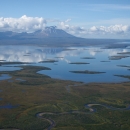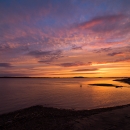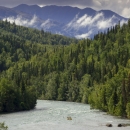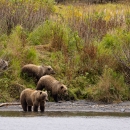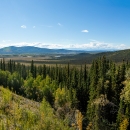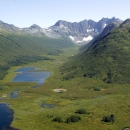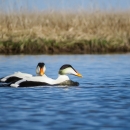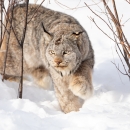Preserving water quality is one purpose of every National Wildlife Refuge in Alaska. Land cover and use can affect the water quality of rivers, lakes and other surface waters. Potential sources of point- and non point-source pollution, such as communities and resource development projects, can threaten refuges' waters. Baseline water quality data provide a benchmark for identifying and quantifying the degree of contamination or change. On most of Alaska's refuges, there are limited or no water quality data available. Our Water Resources Branch began a water quality program in the summer of 2001 to monitor water chemistry. Field measurements are made of physical parameters at stream gage sites and samples are collected and analyzed for major inorganic ions, nutrients, and trace metals several times each year.
We operate a network of stream discharge gages to quantify the occurrence and distribution of surface water refuges across Alaska and collect stream discharge data continuously over 6 year periods. We analyze preliminary data on an annual basis, and prepare final reports at the conclusion of each 6 year study. Report results support water rights applications to maintain instream flows.
This collection includes detailed stream flow information at 79 locations in Alaska. Stream flow data are available for 21 gage sites on the Arctic and Yukon Flats national wildlife refuges. Stream flow data from 15 sites on the Kenai Refuge concluded in 2000 and only preliminary data are available at this time. Innoko Refuge stream flow data for 9 sites will be published and available in the near future. Stream flow data are being collected and analyzed for an additional 30 gage sites located on Becharof, Togiak, Kodiak, and Tetlin refuges. Preliminary data for these stations are available on request.
Lake elevation surveys of selected lakes were conducted to determine lake water surface levels to support instream water right applications. Work conducted by contractors used state-of-the-art Global Positioning System technology to determine lake elevations within centimeter accuracy.
Hydrologic investigations have been completed along the Coastal Plain (1002 Area) of the Arctic National Wildlife Refuge and on the Yukon Flats National Wildlife Refuge. Lake bathymetry data are available for 119 lakes and lake elevation data have been reported for 150 lakes on the Coastal Plain, and 63 lakes in the southern portion of the Yukon Flats National Wildlife Refuge. Water quality data collection began on the Togiak Refuge in 2001 (concluded in 2004), on the Kodiak Refuge in 2003 (concluded in 2007), and on Tetlin Refuge in 2005 (continuing).


